Understanding Chapter 6 of NCERT Class 6 Science
NCERT Class 6 Science Chapter 6 The Living Organisms Characteristics And Habitats Long Questions And Answers
Question 1. Like many animals, although a car also moves, It Is not considered a living organism. Give two or three reasons.
Answer: A car though moving is not considered a living organism because Living organisms can move on their own, whereas a vehicle moves by the burning of fuel; like diesel and petrol. Like all living organisms, a car does not show any other living characteristics like respiration, digestion, reproduction or growth.
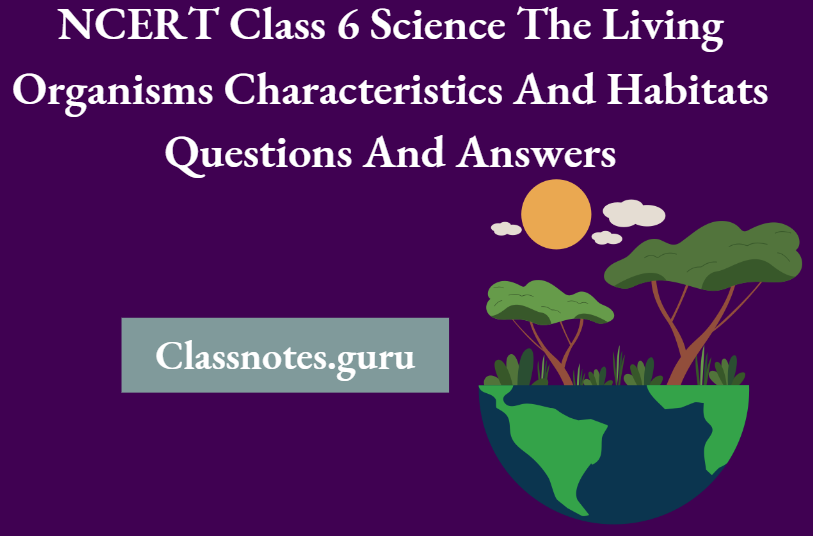
Question 2. Ravi and Ritu went on a vacation to different places. They went to Rishikesh, Himalayas, Kerala, and Rajasthan. They saw many kinds of trees, plants and animals, e.g. pine trees in the Himalayas and cacti In Rajasthan. All the places were so different from each other. They clicked pictures, collected samples and showed Them to their teacher asking them to explain the reason behind these variations.
Read and Learn More Class 6 Science Question And Answers
- Why is there a difference In the type of plants growing In different places?
- What do you mean by the survival place of an organism?
- How many types of such places that give living organisms shelter, food, etc. are you aware of?
- Give an example of variation in plants from different regions.
Answer:
- Plants growing in different places appear different due to the presence of unique adaptive features which can be morphological or physiological.
- It is called a habitat. It provides food, water and shelter, on it. to all living organisms.
- Two types of habitats have been observed
- Terrestrial
- Aquatic.
- Leaves of cactus present in desert, are either absent or are very small and spiny to reduce water loss through transpiration.
- While leaves of trees like deodars are needle-shaped to let snow falling on them slide off easily.
Question 3. Riya lives in Delhi. During her vacations, she went to Leh with her parents. They all were fine on the way. When they reached Leh, all of them started feeling nauseous and complained of headaches and breathing difficulties. A man travelling with them told them to rest for a few days and everything would be fine. After a few days, Riya observed that the man was right and they were feeling fine.
- Why was Riya and her family suffering from these symptoms?
- After 2-3 days everybody was fine. Why?
- Explain what happened.
Answer: Riya and her family were suffering from these symptoms because they were present at high altitude regions where oxygen supply is limited.
After a few days, everybody’s body had adjusted to the conditions of the mountain region.
When we go from plains to mountains, our body faces difficulties due to the sudden changes it is exposed to. After a few days, however, they all get acclimatised to these sudden changes.
NCERT Class 6 Science Chapter 6
Question 4. A caterpillar coils when touched
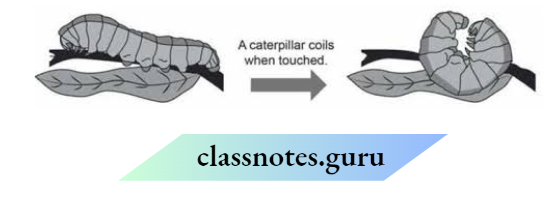
- Which feature of the caterpillar Is shown In the picture?
- It grows
- It reproduces
- It breathes through tiny pores on its bodies
- It responds to changes in the environment
- The green colour of a caterpillar helps It to blend with the green leaves. Explain how this helps the caterpillar.
Answer: It responds to changes in the environment.
The green colour of a caterpillar helps it get camouflaged with green leaves. This blending of colour protects the caterpillar from the predators like insects.
Question 5. Sea lions are mammals that live in the seas.
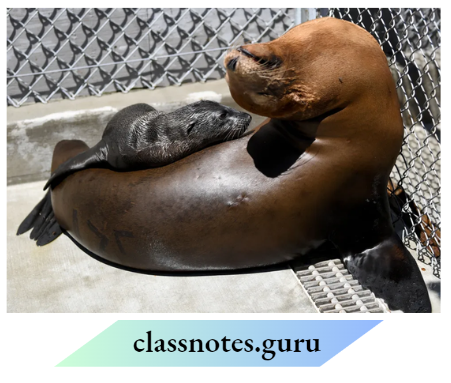
Some common features of sea lions are
- A streamlined body
- Whiskers on the face
- Short fur on the body
- Limbs shaped like flippers
- A layer of fat under the belly
What does the picture show about sea lions?
- They feed mainly on fish
- They enjoy resting on rocks
- They can see underwater
- They produce babies that look similar to adults
- Which two features of sea lions listed above help them swim in water?
Answer:
- They produce babies that look similar to adults.
- The two features of sea lions that help them to swim in water are as follows
- A streamlined body
- Limbs shaped like flippers
Question 6. The given picture is of a desert ecosystem. The biotic component of this ecosystem is the
- Date plan
- Sand Dune
- Sunlight
- Water
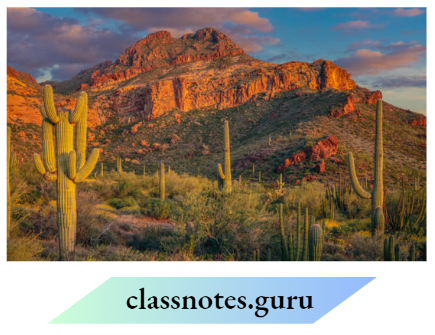
Adaptations in Organisms
Explain any two adaptations observed in a cactus that help it to survive in a desert.
Answer:
- Date palm
- The two adaptations observed in a cactus that help it to survive, in a desert are as follows (a) Roots are very deep for absorbing water from larger areas.
- Roots are very deep for absorbing water from larger areas.
- Leaves are either absent or very small and spiny to reduce water loss through transpiration.
Question 7. The picture shows a cactus. It Is found In hot deserts. Explain how the leaves of the cactus help it to survive In its habitat.

Answer: In cactus, leaves are reduced to spines. Which prevents loss of water (through transpiration). This adaptation helps them to survive in hot deserts
NCERT Class 6 Science Chapter 6
Question 8. State and explain any two features observed in a lotus plant that help it to adapt to an aquatic habitat.
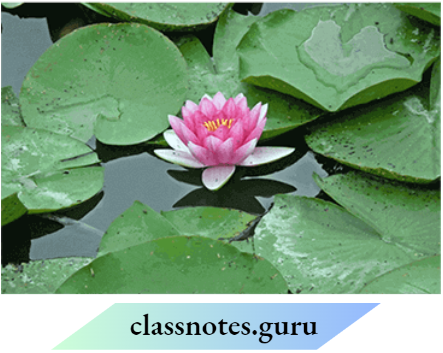
Answer: Two features observed in a lotus plant that help it to adapt to an aquatic habitat are
- The stems are long, hollow and light. This feature makes their stem buoyant.
- The stems grow up to the surface of water and the leaves and flowers float on the surface of water. This increases the exposure to light.
Question 9. The picture shows different animals

Which animals In the picture live In the same habitat?
- Starfish and snail
- Earthworm and snail
- Earthworms, ants and snail
- Snail, starfish and earthworm
What Is common to all the animals in the picture? Circle ‘Yes’ or ‘No’ for the correct response.

Answer:
- Earthworms, ants and snail
- No
- Yes
- Yes
NCERT Class 6 Science Chapter 6 The Living Organisms Characteristics And Habitats Short Questions And Answers
Question 1. What are the surroundings of plants and animals in the sea and desert?
Answer: In the sea, plants and animals are surrounded by saline (salty) water. Most of them use the air dissolved in water. In the desert, there is very little availability of water.
It is very hot during the daytime and very cold at night in the desert. The animals and plants of the desert live on the desert soil and breathe air from the surroundings.
Question 2. Are sunlight and heat biotic or abiotic components?
Answer: Sunlight and heat are abiotic components
Question 3. Which of the following are living? A forest, trees, creepers, small and big animals, birds, snakes, Insects, rocks, soil, water, air, dry leaves, dead animals, mushrooms and moss.
Answer: Living things are as follows A forest, trees, creepers, small and big animals, birds, snakes, insects, mushrooms and moss.
Question 4. How can you distinguish between living and non-living things?
Answer: The differences between living and non-living things are as follows
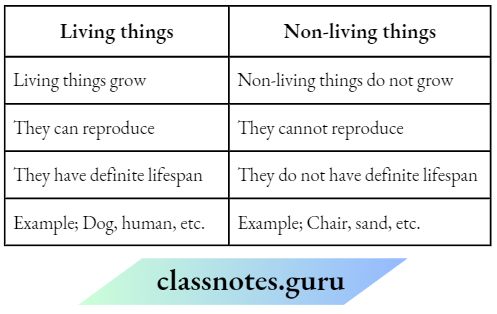
Question 5. Do non-living things show growth?
Answer: Yes, non-living things show growth. They increase in size and mass, for example; clouds.
Question 6. Can we live without breathing?
Answer: No, we cannot live without breathing. It is a part of a process called respiration. It is through respiration that the body finally obtains energy from the food it takes.
Question 7. How do we respond, if we suddenly step on a sharp object like a thorn, while walking barefoot?
Answer: If we suddenly step on a sharp object like a thorn, while walking barefoot we withdraw our foot.
Question 8. How do we feel when we see or think about our favourite food?
Answer: When we see or think about our favourite food, water starts filling our mouths.
Question 9. What happens when we suddenly move from a dark place to bright sunlight?
Answer: When we suddenly move from a dark place to bright sunlight our eyes shut themselves automatically for a moment till they adjust to the changed bright surroundings.
Question 10. Give some examples of responses of animals to stimuli.
Answer: Some examples of responses of animals to stimuli are as follows
- Wild animals run away when a bright light is flashed towards them.
- Cockroaches begin to move to their hiding places if the light in the kitchen is switched on at night.
Question 11. Do plants respond to stimuli?
Answer: Yes, plants respond to stimuli. For example, in some plants, flowers close after sunset and in some plants like ‘touch-me-not’, leaves close when touched.
Question 12. What is a habitat?
Answer: The place where organisms live is called habitat. It means a dwelling place (a home).
Question 13. How are cactus adapted to survive in a desert?
Answer: To survive in a desert, a cactus has the following adaptations
- Leaves are either modified into spines or are absent to prevent water loss through transpiration.
- Stem is modified to perform photosynthesis and covered with a thick waxy layer to retain water.
- The root system of the cactus is well-developed and grows deep to absorb water.
Question 14. Which of the things in the following list are non-living? Plough, mushroom, sewing machine, radio, boat, water hyacinth, earthworm
Answer: Non-living things do not possess life and do not need food, air or water. Thus, in the given list plough, sewing machines, radios and boats are non-living objects.
NCERT Class 6 Science Chapter 6
Question 15. Give an example of a non-living thing which shows any two characteristics of living things.
Answer: A cloud is an example of a non-living thing which shows the following two characteristics of living things
- It increases or decreases in size.
- It shows movements.
- (Another example can be a car which moves from one place to another and also requires energy, i.e. petrol).
Question 16. Which of the non-living things listed below, were once part of a living thing? Butter, leather, soil, wool, electric bulb, cooking oil, salt, apple, rubber
Answer: The following are the non-living things from the list which were once part of living things
- Butter Obtained- from milk from dairy animals
- leather- From animal skin
- Wool- From the hair of sheep or goat
- Cooking oil- Seeds Of plants
- Apple- Fruit From Apple Tree
- Rubber- Latex Of Rubber Tree.
Question 17. List the common characteristics of the living things.
Answer: Living things have the following common characteristics-
- Growth
- Movement
- Reproduction
- Respirator
- Respond to stimuli
- Excretion
Question 18. Explain why speed is important for survival in the grasslands for animals that live there. Hint There are few trees or places for animals to hide in grassland habitats.
Answer: In grasslands, there are a limited number of trees and places for animals to hide. When the enemy attacks an animal, it has to run fast, to reach a safe place. If it fails, it has to lose its life. So, speed in such places as grasslands is very important for the survival of animals.
Question 19. A habitat Is said to have two supporting components. What are they?
Answer: A habitat includes
- A living component is called an abiotic.
- Non-living components are called abiotic.
Question 20. Why do desert snakes burrow deep into the sand
Answer: Snakes in the desert burrow deep into the sand during the daytime because the deeper layers of sand are cooler which allows them to stay away from the heat of the desert that persists through the daytime.
Question 21. Some desert plants have very small leaves, whereas some others have only spines. How does this benefit you during the day? the plants?
Answer: Desert plants have very small leaves or spines as adaptations to dry conditions. Because of these modifications, the surface of the lamina is reduced thereby reducing water loss by transpiration as water is scarce in desert habitats.
Question 22. The presence of needle-like leaves on trees growing in extreme cold helps them to survive the cold conditions. Explain.
Answer: Many mountain trees have small, needle-like leaves due to which these leaves lose very little water in windy conditions. This helps the mountain trees to survive in winter when all the soil water is frozen in the form of ice and not available to their roots.
The needle-like leaves have a thick waxy layer (or cuticle) to reduce the loss of water through transpiration and to protect them from damage by rain and snow.
Question 23. An animal has a round body, small ears and thick fur on its body, feet and toes. This animal has a thick layer of fat beneath its skin to provide insulation.
- The feet of this animal Are also bigger.
- Identify this animal.
- Name the possible habitat of this animal.
Answer: This animal is a snow leopard.
The habitat of this animal is the mountain where snow is present.
Question 24. Explain why many mountain trees are cone-shaped having sloping branches.
Answer: The trees in mountain habitats are usually cone-shaped having sloping branches because this shape of the mountain trees makes the rainwater and snow slide off easily without damaging the branches and leaves.
Question 25. What are the specific features present In a deer that help It to detect the presence of predators like lions?
Answer: A deer has the following specific features that help it to detect the presence of predators like lions.
- Long ears to hear the movement of predators.
- Eyes on the sides of its head which allows it to look in all directions.
Adaptations in Organisms
Question 26. Aquatic plants undergo some modifications to adapt to their habitat. List any two of those.
Answer: Two adaptations of aquatic plants are
- The roots of these plants are small just to keep the plant in place.
- Stems are hollow with large spaces which help in floating.
Question 27. Write the adaptation in aquatic plants due to which
- Submerged leaves can bend in the flowing water
- Leaves can float on the surface of water
Answer: The Adaptations in Organisms
- Leaves ofsubmerged aquatic plants are narrow and ribbon-like which allows them to bend in the flowing water.
- Stems/Stalks of leaves of aquatic plants are long, hollow and light which allows them to float on the surface of water.
Question 28. Read the features of different plants given below
- Thick waxy stem
- Short roots
- Cone-shaped plants
- Sloping branches
- Small or Spine like leaves
- Hollow stem
Choose the type of plant for every adaptive feature given in a, b, c, d, e and f from the list given below Aquatic plant, desert plant, mountainous plant.
Answer: Given below are the features of their corresponding type of plant,
- Thick waxy stem – desert plant
- Short roots – aquatic plant
- Cone-shaped plants-mountainous plants
- Sloping branches – mountainous plant
- Small or Spine leaves- desert plant
- Hollow stem – aquatic plant
Question 29. Montlonono adaptation present In the following
- In camels to keep their bodies away from the heat of sand.
- In frogs to enable them to swim.
- Dolphins and whales breathe In air when they swim near the surface of the water.
Answer: Camels have long legs to keep their bodies away from the heat of sand.
- Frogs have webbed feet that enable them to swim,
- Dolphins and whales have blow holes which help them to breathe in air when they swim near the surface of water.
Question 30. List the types of movements seen In plants.
Answer: We sec the following movements in plants
- Opening and dosing off lower.
- Growth of stem and leaves.
- Growth of stems and twigs towards light and roots towards soil and water.
Question 31. Pahell has a rose plant In her garden. How can she Increase the number of rose plants In the garden?
Answer: Paheli can increase the number of rose plants in the garden by planting stem cuttings of the rose plant. This will lead to the reproduction of the rose plant.
Question 32. Plants are also called living beings. Mention any two characteristics that support this classification.
Answer: Plants are called living beings because
- They carry out the respiratory process.
- They respond to stimuli.
- A car though moves is not considered a living organism because of the following reasons
- Living organisms can move on their own, whereas a car moves by the burning of fuel; like diesel and petrol.
- Like all living organisms, a car does not show any other living characteristics like respiration, digestion, reproduction or growth.
NCERT Class 6 Science Chapter 6 The Living Organisms Characteristics And Habitats Very Short Questions And Answers
Question 1. Camels live in desert habitats. How do they adapt to such a harsh climate?
Answer: Camels have long legs, a hump and padded feet. All of these are adaptive features that help camel to survive in desert habitats.
Question 2. Name the place where an organism lives and gets its food.
Answer: Habitat is a place where an animal lives and gets its food.
Question 3. Using the following words, write the habitat of each animal given in figures (a to d). Grassland, mountain, desert, pond, river
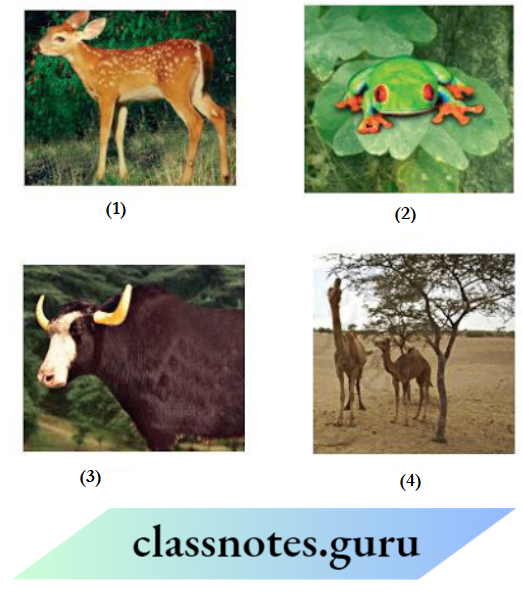
Answer:
- The diagram is of a deer which lives in grassland
- The diagram is of a frog which lives in the pond
- The diagram is of a yak which lives in the mountain
- The diagram is of a camel which lives in the desert
Question 4. Classify the following habitats into terrestrial and aquatic types. Grassland, pond, ocean, rice
Answer: The habitats can be classified as
- Terrestrial habitats
- — Grassland and rice field
- Aquatic habitats — Pond and ocean
Question 5. Adaptation to habitat does not take place in a short time. Explain.
Answer: It takes thousands of years for the abiotic factors to change and support the animals and plants present there,
Question 6. Animals like mountain goats and snow leopards do not slip or fall. Why?
Answer: These animals have big and padded feet and strong hooves to spread their weight which prevents them from slipping and falling on the mountains.
Question 7. Mention two ways by which animals cope with low temperatures.
Answer: Animals living in colder areas have hairy skin and a thick layer of fat under their skin to warm their bodies.
Question 8. Name the adaptation of hiding by merging with the surroundings.
Answer: Camouflage.
Question 9. Leaves of mountain trees prevent damage by snow or rain. How?
Answer: The needle-like leaves of these trees have a thick waxy layer called cuticle which protects the leaves from any kind of damage.
Question 10. Lions have very high agility. Why do they need this type of adaptation?
Answer: As a predator, they have to hunt for food which is not easy as prey like deer are very fast. Thus, they have high agility.
Question 11. A few animals can live in both places, i.e. land and water. Name at least two.
Answer: Few animals have adaptations to live both in water as well as land. These are called amphibians, e.g. frogs and toads.
Question 12. An adaptation requires a change In the body shape of the animals present. Name the habitat and the modification present.
Answer: Animals in aquatic habitats have streamlined bodies which help them survive underwater.
Question 13. Growth is an important characteristic of living beings. Support this statement.
Answer: Growth represents an increase in the weight and size of living beings as time passes. Non-living things do not grow over time.
Question 14. During respiration, gases are exchanged in our lungs. What are these gases? Answer: Carbon dioxide is given off and oxygen is taken in by our lungs.
Question 15. Why is reproduction important for organisms?
Answer: Reproduction is important for organisms as it leads to the production of more individuals of their kind. This helps in the continuity oflife on the Earth.
Question 16. Unscrnmblo tho words given below to got tho correct words using tho clues given against them.
- SATPADAOINT specific features or certain habits which enable a living being to live In Its surroundings.
- RUTRCQXNI waste products are removed by this process.
- LUMISIT all living things respond to these.
- ROUCDPRENTOI Because of this we find organisms of the same kind.
Answer:
- Adaptations
- Excretion
- Stimuli
- Reproduction.
NCERT Class 6 Science Chapter 6 The Living Organisms Characteristics And Habitats Fill In the blanks.
1. The presence of specific features which enable a plant or an animal to live in a particular habitat is called adaptation
2. The habitats of the plants and animals that live on land are called terrestrial
3. The habitats of plants and animals that live in water are called aquatic
4. Soil, water and air are the habitat abiotic
5. Changes in our surroundings that make us respond to them are called stimuli
6. Plants and animals living on land, are called terrestrial organisms.
7. Soil, water and air are the abiotic components of a habitat.
8. Desert plants have long roots for better absorption of minerals and water.
9. Some objects are characterised as living while others as non-living
10. The animals depend on it for their food plants.
11. Webbed feet is a feature found in frog
12. A habitat has biotic and Abiotic components that interact with each other.
13. Fishes have gills for respiration.
NCERT Class 6 Science Chapter 6 The Living Organisms Characteristics And Habitats True Or False
1. Fin is for aquatic life in fishes. True
2. Mountain is a special terrestrial habitat with low temperature. True
3. Almost all types of plants are found in the sea. False, Only Those Plants that are adapted to aquatic Habitats are found in the sea.
4. Frog has dry skin. False, the frog has wet and slimy skin
5. All living beings need water. True
6. The non-living objects carry out respiration. False, non-living things cannot carry out respiration. It is a feature of living things.
7. Leaves of touch-me-not plant curl up when touched. True
8. In cacti, leaves are reduced to spines. True
NCERT Class 6 Science Chapter 6 The Living Organisms Characteristics And Habitats Assertion-Reason Questions
The following questions consist of two statements. Assertion (A) and Reason (R). Answer these questions by selecting the appropriate option given below.
- Both A and R are true and R is the correct explanation of A
- Both A and R are true, but R is not the correct explanation of A
- A is true, but R is false
- A is false, but R is true
1. Assertion (A) Forests, grasslands, deserts and mountain regions are examples of terrestrial habitats.
Reason (R) The plants and animals that live on land are said to live in terrestrial habitats.
2. Assertion (A) The eyes of a lion are in front of the face.
Reason (R) They help to get the correct idea about the location of its prey.
3. Assertion (A) Non-living things react to changes in their surroundings.
Reason (R) Changes in surroundings that make us respond to them are called stimuli.
Answer:
- Both A and R are true, but R is not the correct explanation of A.
- Both A and R are true and R is the correct explanation of A.
- A is false, but R is true. A can be corrected as Living things react to changes in their surroundings, i.e. they respond to stimulus.
NCERT Class 6 Science Chapter 6 The Living Organisms Characteristics And Habitats Match The Columns
Question 1. Match the Column 1 with Column 2.
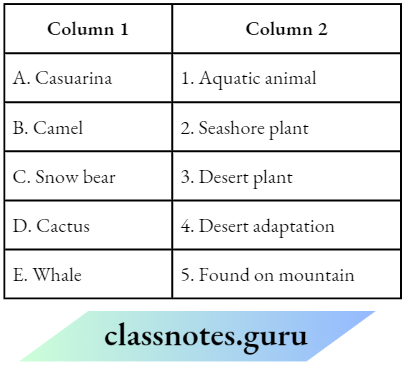
Answer: A-2, B-4, C-5, D-3, E-1
Question 2. Match the Column 1 with Column 2.
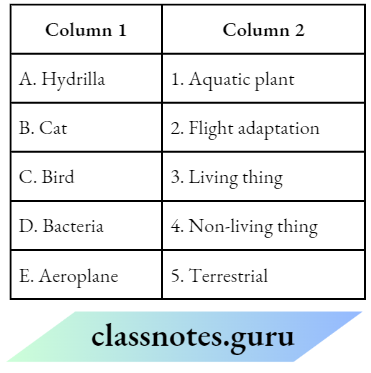
Answer: A-1,B-5, C-2, D-3.E-4
Question 3. Match the Column 1 with Column 2.
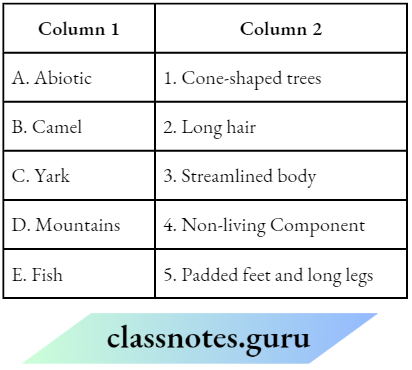
Answer: A-4, B-5.C-2, D-1, E-3
